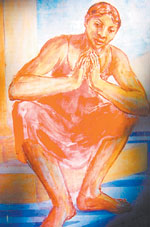| Plus |
|
|||
|
Our
tradition, their talent Invited by Ven. Kalyanatissa Thero to take on the challenge of painting murals on the walls of the ancient Giniwella Purana Vihara, Noella Roos was in for one of the most fulfilling experiences in her professional career. "But initially I wasn't sure if I could do justice to the project," she says. Resident in Sri Lanka for the past five years, Noella has worked extensively on the Kandy Perahera, producing numerous paintings depicting scenes from the pageant. Together with her father, Eddy Roos, and Rachel Dieraets, both established Dutch artists, who came down to Sri Lanka for the project, Noella completed the murals within three to four months. The "Kataluwa Temple Project" involved the painting of murals on a plain white wall within the Giniwella Purana Vihara. Though the rest of the temple, which needs restoration, is complete with a stupa and shrine room of paintings, this particular wall, meant to be decorated with murals of Buddhist depictions, had been blank for a long time. It was a chance meeting with the Ven. Kalyanatissa Thero, which brought about this interesting amalgamation of foreign talent and Sri Lankan tradition. "It was the Thero's ultimate wish that the murals be painted before his passing away," Noella says. "The two themes we decided to paint were the arrival of the Sacred Tooth Relic and the bringing of the Bo-sapling to Sri Lanka by Theri Sanghamitta. Around the depictions, are portraits of traditional dancers," says Noella. The mural covers a hundred sq. metres of wall and has about 140 figures and many symbols from Buddhism. Though the artists first planned to use natural paints, the time factor was a constraint and they settled for acrylics. Though the paintings are culturally sensitive, they also have a strong sense of Western renaissance style, and so combine the two cultures. Among the others involved in the project were S.P. Charles, an experienced Sri Lankan artist working for the National Museum, Walter Kulasooriya, a Sri Lankan traditional temple and mural painter, Cyril Kulapathi, Champi Kulapathi and Dominic Kanapathy. The project involved almost seventy people and included several Low-Country dancers from Ahangama, Kandyan dancers, local musicians and other residents of the area. To create the exact atmosphere, the artists had dancers and musicians performing around them while they worked. This direct contact with the villagers and their daily life helped give them a clear picture of the Buddhist way of life. A similar merging of time and place can be seen in the Borobudur sculptures and the stone carvings of Java. "We wanted to convey the message that Buddhism was not something of the past, but something taking place here and now. So we merged the two important events of the arrival of Buddhism and the bringing of the Sacred Bo tree with everyday happenings," says Rachel, explaining the concept. The artists and residents, dressed in traditional costumes, were sometimes used as still models, while at other times were painted in motion. "The response from villagers has been very satisfactory, as they could recognise their relatives and friends on the murals," says Noella. It was total commitment from all involved, especially the Thero. "Throughout the entire three months, though being extremely busy, there wasn't a moment when we felt like he didn't want to be there with us. Whenever we had a problem, mostly during lunch time, he would relate a Buddhist religious story to us, and through it show us a way of solving our problem." The artists were assisted financially by the Ven. Kalyanatissa Nayake Maha Thero, the Dutch Embassy and the Prins Bernhard Culture Fund. An exhibition of these paintings and sketches is now on at the Barefoot Gallery and will continue until February 29. Restoring
Giniwella Though the temple's essential features such as the shrine room, stupa and Buddha statue are intact, it needs restoration. In most other areas such as the interior of the shrine room, paintings done during the initial building of the temple do exist. But there are no facilities to restore them even by the Department of Archaeology. In an effort to improve the appearance of the temple, artists Walter Kulasooriya began to prepare the temple walls to be painted with murals. Along with the support of the incumbent Ven. Kalyanitissa Nayake Thero, murals depicting two important events of Buddhism in Sri Lanka; the arrival of Buddhism to the island and the bringing of the Sacred Bo tree. A decorative outline around the doors of the temple, has been added on by the artists, and though the mural is complete, finishing touches are still being done. The Dutch artists, together with the others involved in the "Kataluwa Temple Project" are in the process of collecting funds to restore the Giniwella Purana Vihara. |
||||
Copyright © 2001 Wijeya Newspapers
Ltd. All rights reserved. |
 By
Vidushi Seneviratne
By
Vidushi Seneviratne A
hundred metres away from the Giniwella Vihara, is the ancient Kataluwa
temple, famous for its beautiful ancient murals depicting the Buddha's
life. And so, it was decided that the new murals would consist of
a different depiction.
A
hundred metres away from the Giniwella Vihara, is the ancient Kataluwa
temple, famous for its beautiful ancient murals depicting the Buddha's
life. And so, it was decided that the new murals would consist of
a different depiction.